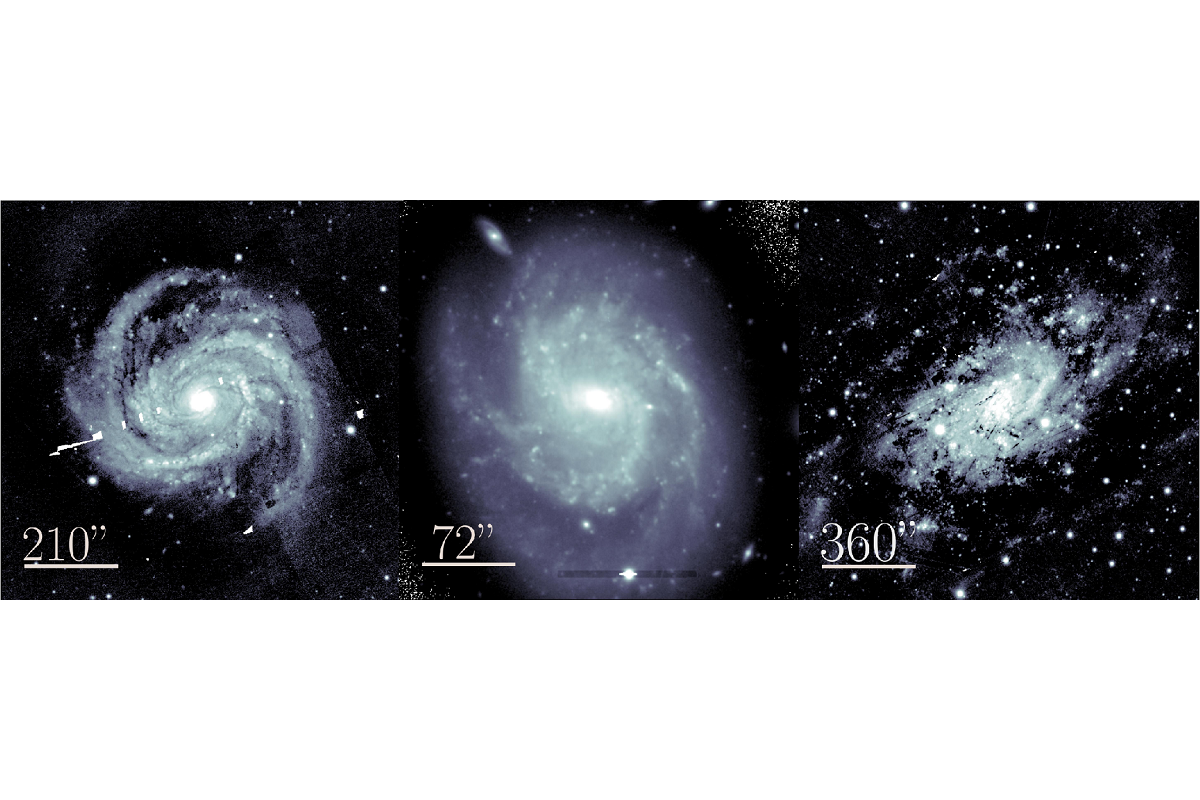Astrophysicists from St Petersburg University demonstrate the existence of multiple mechanisms for spiral formation in galaxies
Scientists from St Petersburg University, in collaboration with their colleagues from Lomonosov Moscow State University and the Central (Pulkovo) Astronomical Observatory, have developed a new method for studying spiral galaxies and have shown, using the example of three such galaxies, that these objects can be formed through different mechanisms. Their findings indicate that the spiral arms of galaxies, including the Milky Way, are more complex in origin than previously assumed.

Many of the star systems known to science — galaxies — exhibit a noticeable clockwise or counterclockwise twist as they extend from the centre, giving them a shape that often resembles a spiral. While most of these objects have two clearly symmetrical spiral arms radiating from the core, some systems display multiple branching arms.
The research findings are published in the scientific journal Galaxies.
According to current data, more than 70% of all observed disc galaxies have a spiral structure — including the Milky Way, within one of whose spiral arms, Orion, the Solar System is located. Theorists propose various models to explain the formation of this phenomenon.
The most widely known is the density wave theory, which can be illustrated by the analogy of a rush-hour traffic jam. Individual cars — representing stars in a galaxy — move in and out of a dense line of vehicles. However, under certain conditions, the traffic jam itself appears to move at a steady speed — much like a wave in the galactic disc — and becomes visible due to the increased density, forming a spiral pattern. Such theories are supported by extensive telescopic observations, some of which now enable astronomers to discern fine details in the spiral structures.
An alternative approach is to use numerical computer simulations of the galaxy composed of gas particles and stars, allowing researchers to study it in detail. The scientists from St Petersburg University are among the global leaders in these simulations. However, even the most advanced simulations — incorporating a vast number of particles — often struggle to reproduce a spiral pattern that closely resembles observed structures and remains stable over long timescales (in galactic terms).
St Petersburg University also conducts significant research in space exploration, including the development of advanced methods and instruments for more effective space studies. For example, scientists from St Petersburg University were the first in the world to investigate bacterial biofilms in space and are now studying the impact of spaceflight on the human body, modelling the processes responsible for cosmic explosions, and much more. Click here to read more about the contributions of St Petersburg University researchers to the exploration of space. As part of this year’s St Petersburg University Day celebrations, the crew of Expedition 71 presented to the St Petersburg University History Museum the flag that had travelled to the International Space Station in the year of the University’s 300th anniversary. The cosmonauts were guests on St Petersburg University’s popular science podcast Heinrich Terahertz, where they spoke about scientific experiments conducted in orbit, their hobbies, and their favourite works of literature.
The study of spiral galaxies provides a means to test terrestrial physics on cosmic scales, including the laws of gravity, the nature of dark matter, and the properties of stars. At present, the mechanisms behind the formation of spiral structures remain largely unclear and are therefore a subject of active astrophysical research.
The scientists from St Petersburg University, in collaboration with their colleagues, have been using observational data to identify features in galaxies that may correspond to specific spiral formation mechanisms.
The principal challenge is that such distinguishing features are relatively rare. For example, the density wave theory proposes that the spiral pattern rotates with a constant angular velocity (so-called ‘solid-body’ rotation), while alternative models suggest that angular velocity decreases with increasing distance from the galactic centre, as observed in galactic discs.
Alexander Marchuk, Senior Research Associate in the Laboratory of Observational Astrophysics at St Petersburg University
The experts examined how the spiral arms of galaxies rotate, focusing on special regions known as corotation radii — where the spiral arms and the disc rotate at the same speed. If the spiral pattern rotates as a whole, there will typically be a single corotation radius. However, if different parts of the galaxy rotate at varying speeds, there may be multiple such zones — or none at all.
To explore this in detail, the researchers selected three galaxies: one with consistent measurements of a single corotation radius; one with ambiguous data across the disc; and one in which multiple corotation zones are possible. To independently confirm their hypotheses, the researchers employed several complementary approaches: they observed the motion of gas within the galaxies, analysed the distribution of stars of different ages, and compared ultraviolet and infrared images using a specialised programme developed for this purpose.
The study revealed that spiral arms in galaxies are far more complex than previously assumed. Our comprehensive analysis — including the study of stellar motion, composition, and luminosity across different spectral bands — confirmed that all three galaxies exhibit distinct spiral structures.
Alexander Marchuk, Senior Research Associate in the Laboratory of Observational Astrophysics at St Petersburg University
As the scientists noted, galaxy M100, which has well-defined spiral arms, showed no evidence of a density wave — contrary to the prevailing theory that spirals in such galaxies should rotate as a single unit. In the other two galaxies, NGC 3686 and NGC 2403, the researchers reliably detected, for the first time, the presence of one and two distinct types of density waves, respectively. This study has thus provided valid and reliable examples of different types of spiral structures, offering new insights into their nature and paving the way for the development of improved analytical methods.

